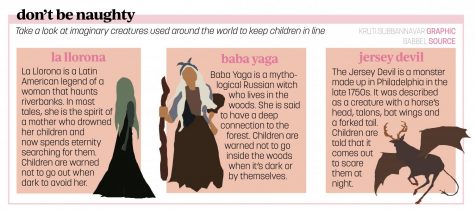Junior Alexandra “Ally” Shaw said she remembers when she discovered Santa was not real. Shaw said she remembers discovering the discarded box in the recycling bin that carried hers and her older brother’s presents the morning after Christmas, and that was when she learned the truth about the internationally known symbol of Christmas joy.
Senior Lillian Williams also said she believed in Santa Claus as a child and said she believed in it more as a symbol of Christmas rather than as the character that would shimmy down a chimney to drop presents. She also said she had a time where she believed Santa would come and said she had memories of leaving out carrots for the reindeer.
They’re not alone. According to research by the U.S National Library of Medicine (NCBI), 85% of children in the USA believed that the titular character Santa Claus was real.
“It’s just the earth-shattering revelation that your parents lied to you that sticks out in my mind right now,” Shaw said.
However, Shaw said she doesn’t mind the lie of being told about Santa and other imaginary characters such as the tooth-fairy and the Easter Bunny as she said she believes that they are a tradition passed down from generations of parents to create stories and good memories for their children. Williams also said she never saw Santa Claus a lie, but rather as a tradition to carry forward.


“I think that’s a lot of the reason why parents do things for the family, just to do something fun,” she said.
Williams also said it was not that huge of a shock when she finally realized that the characters were not real, as she said she came to the revelation gradually.
School psychologist Kristina Bonnet said believing in imaginary characters, whether popular or self-made, is good for children.
“It can certainly be beneficial for children to believe in imaginary friends or characters. It helps grow their imagination and it is good for (their) development,” Bonnet said via email. “It’s actually a sign of creativity, not loneliness. This creativity can extend long past their childhood years.”
According to child psychologist Sally Goddard Blythe, director of the Institute for Neuro-Physiological Psychology, “‘Imagination is the ability to create visual images in the mind’s eye, which allows us to explore all sorts of images and ideas without being constrained by the limits of the physical world. This is how children begin to develop problem-solving skills, coming up with new possibilities, new ways of seeing and being, which develop important faculties in critical thinking that will help the child throughout life.’”
Shaw and Williams also talked about creating their own original characters, better known as OC’s.
Williams said she started creating her own characters by third grade, when she began to get into drawing. Shaw said she was inspired by Minecraft YouTubers in middle school to create her own character, who now has her own story that Shaw updates as she draws the story out for people to enjoy on her Instagram account. Williams also posts her creations on Instagram and constantly updates it as she draws something new.
Williams said she was inspired to make her own characters by existing series’ characters, and said she kept thinking about the different ways a character could be perceived in a different way from how they were originally portrayed in the show.
“People get creative and it inspires you to get creative,” Shaw said. She said hearing other people’s passion for their own creation was a push in the direction where she wanted to go in creating imaginary characters.
Shaw said the process of drawing her characters starts with creating a basic shape, inking, then coloring with many more steps in between, but it requires a lot of time and dedication.
“There’s a lot of effort, care, some tears if you’re having a bad day, and overall (that’s how the characters are made),” she said.
Shaw said she understands the feeling of pride that people get when creating their own characters.

She said as she goes along the journey with her character, giving the characters backstories and helping them develop through the plot, it feels like raising kids.
Williams said it was a fun experience for her to create and develop her characters and then share them with the world.
“When I look back on how far I’ve gone on some of my characters, where they start and how they end up, I do feel a little bit of pride,” Shaw said.
Shaw said she believes relating to characters and being invested in them is good for teens’ emotional states as they can deal with their emotions through projecting on certain characters.
“I think there has been a huge growth in escapism in fiction, I think it’s always been there, but it’s more prevalent in our generation because of social media. (Social media) is an amplifier for a lot of things that already exist in the world, you just see it and notice it more,” Williams said.
Ultimately when it comes down to believing in imaginary characters, Shaw said she would tell her children about Santa as she said wants her children to continue a tradition of allure and gift-giving. Williams said she agreed with that sentiment as well.
Shaw said she encouraged others to pursue their own creative avenues without fear.
“For all who want to make OCs but are scared, cringe culture is dead,” Shaw said. “It’s dead, I’ve killed it personally and if you want to write OCs, write it as long as…it isn’t hurting anyone.”
































![What happened to theater etiquette? [opinion]](https://hilite.org/wp-content/uploads/2025/04/Entertainment-Perspective-Cover-1200x471.jpg)














































![Review: “The Immortal Soul Salvage Yard:” A criminally underrated poetry collection [MUSE]](https://hilite.org/wp-content/uploads/2025/03/71cju6TvqmL._AC_UF10001000_QL80_.jpg)
![Review: "Dog Man" is Unapologetically Chaotic [MUSE]](https://hilite.org/wp-content/uploads/2025/03/dogman-1200x700.jpg)
![Review: "Ne Zha 2": The WeChat family reunion I didn’t know I needed [MUSE]](https://hilite.org/wp-content/uploads/2025/03/unnamed-4.png)
![Review in Print: Maripaz Villar brings a delightfully unique style to the world of WEBTOON [MUSE]](https://hilite.org/wp-content/uploads/2023/12/maripazcover-1200x960.jpg)
![Review: “The Sword of Kaigen” is a masterpiece [MUSE]](https://hilite.org/wp-content/uploads/2023/11/Screenshot-2023-11-26-201051.png)
![Review: Gateron Oil Kings, great linear switches, okay price [MUSE]](https://hilite.org/wp-content/uploads/2023/11/Screenshot-2023-11-26-200553.png)
![Review: “A Haunting in Venice” is a significant improvement from other Agatha Christie adaptations [MUSE]](https://hilite.org/wp-content/uploads/2023/11/e7ee2938a6d422669771bce6d8088521.jpg)
![Review: A Thanksgiving story from elementary school, still just as interesting [MUSE]](https://hilite.org/wp-content/uploads/2023/11/Screenshot-2023-11-26-195514-987x1200.png)
![Review: "When I Fly Towards You", cute, uplifting youth drama [MUSE]](https://hilite.org/wp-content/uploads/2023/09/When-I-Fly-Towards-You-Chinese-drama.png)
![Postcards from Muse: Hawaii Travel Diary [MUSE]](https://hilite.org/wp-content/uploads/2023/09/My-project-1-1200x1200.jpg)
![Review: "Ladybug & Cat Noir: The Movie," departure from original show [MUSE]](https://hilite.org/wp-content/uploads/2023/09/Ladybug__Cat_Noir_-_The_Movie_poster.jpg)
![Review in Print: "Hidden Love" is the cute, uplifting drama everyone needs [MUSE]](https://hilite.org/wp-content/uploads/2023/09/hiddenlovecover-e1693597208225-1030x1200.png)
![Review in Print: "Heartstopper" is the heartwarming queer romance we all need [MUSE]](https://hilite.org/wp-content/uploads/2023/08/museheartstoppercover-1200x654.png)


